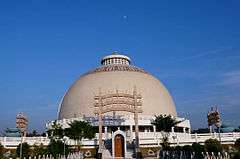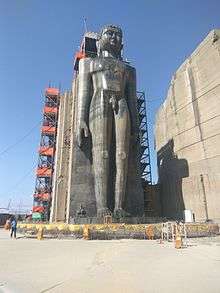Religion in Maharashtra
Religion in Maharashtra is characterized by a diversity of religious beliefs and practices. Maharashtra possesses six of the world's major religions; namely Hinduism, Islam, Buddhism, Jainism, Christianity and Sikhism. Throughout Maharashtra's history, religion has been an important part of the state's culture.
The Constitution of India declares the state to be a secular republic that must uphold the right of citizens to freely worship and propagate any or no religion or faith.[2][3] The Constitution of India also declares the right to freedom of religion to be a fundamental right.
Religions


.jpg)


Hinduism
Hindus form 79.83% of the state's total population as per 2011 census and Hinduism plays an important role in the lives of the Maharashtrian people in their day-to-day life. Ganesh is the most popular deity amongst Marathi Hindus,[4] followed by Krishna in the form of Vithal. They also worship the Shiva Family deities such as Shankar and Parvati. The Warkari tradition holds a strong grip on the local Hindus of Maharashtra. The public Ganesh festival started by Lokmanya Tilak in the late 19th century is very popular. Marathi Hindus also revere Bhakti saints, such as Dnyaneshwar, Savata Mali, Tukaram, Namdev and Chokhamela and Banjara, Rashtrasant Tukdoji Maharaj (Sant as well as Philosopher), Sant Gadge Maharaj (Sant as well as Philosopher) and Dr. Babasaheb Ambedkar (Spiritual leader of Buddhist and dalits).
Islam
Islam is the second largest religion in the state, with 12,967,840 adherents comprising 11.54% of the population, per estimates. Eid-ul-Fitr (Ramzan Eid) and Eid-ul-Azha (Baqar Eid) are the two most important Muslim festivals in the state. The overwhelming majority of Muslims in the state are Sunnis. The population in the state is both highly urbanised, and is spread across different regions. Significant Muslim populations can be found in Marathwada, Khandesh, and Mumbai-Thane belt. The Vidarbha, Western Maharashtra and Konkan regions also house sizeable Muslim populations. The urban character of the community in Maharashtra can be seen from the fact that Mumbai, the capital city of Maharashtra, is approximately 18.8% Muslim per the Census.[5] Similarly, Nagpur, the second capital of Maharashtra, has population that is 11% Muslim. In Aurangabad City, Muslims form 30.79%[6] of the population. Muslims also form a majority in towns like Malegaon and Bhiwandi.
Buddhism
Buddhism is the third largest religion in the state. Buddhism accounts 6% in Maharashtra's total population. 6,531,200 people are followers of Buddhism in Maharashtra as per 2011 census. Maharashtra account for 77.36% of all Buddhists in India.[7] Most Marathi Buddhists are followers Navayana Buddhism of the Dalit Buddhist movement, a 19th and 20th-century Buddhist revival movement in India that received its most substantial impetus from Dr. Babasaheb Ambedkar who called for the conversion of Dalits to Buddhism to escape a caste-based society that considered them to be the lowest in the hierarchy.[8]
Jainism
Jains are a major group in Maharashtra. Jain community census for 2011 in Maharashtra area was 1,400,349 (1.25%). They are mostly concentrated in the urban cities in Western Maharashtra.
The vast majority of Jains in Maharashtra originate from the Marwad and Mewad regions of Rajasthan and from the state of Gujarat. There is a tiny indigenous Marathi Jain community in Maharashtra. Rulers of Maharashtra from the 1st millennium CE such as Rashtrakuta and the Chalukya were followers of Jain religion. Along with Hindu and Buddhist caves, there are a number of Jain caves at the ancient cave complex of Ellora.
Christianity
Christians account for 1,080,073 or 0.96% of Maharashtra's population. Most of the Christians are Catholics and Protestants. There are also Goan, Mangalorean, Keralite and Tamilian Christians in the urban pockets of Mumbai and Pune. There are two ethnic Christian communities in Maharashtra:
- East Indians – Majority Catholics, concentrated in Mumbai and in the neighbouring districts of Thane and Raigad. St Bartholomew preached to the natives of this region in the 1st century AD.
- Marathi Christians – Majority Protestants found specially in Ahmednagar and Solapur. Protestantism was brought to these areas by American and Anglican missionaries during the 18th century. Marathi Christians have largely retained their pre-Christian cultural practices.
- In the early 19th century some people converted to Christianity during famine in Ahmednagar and Miraj.[9] They converted after evangelization by American Marathi Mission, Church Mission Society and United Society for the Propagation of the Gospel by the Church of England at Ahmednagar.[10] In Ahmednagar, Missionary travelled between villages to explain the Bible to locals.[11] who brought these people to Christianity. However, this Christian conversion movement was overshadowed by the emergence of B. R. Ambedkar and the large-scale conversion to Buddhism.[12]
Sikhism
There is a sizeable Sikh population in Maharashtra, with the 2011 census indicating 223,247 or 0.20% adherents.[13] Nanded, the second largest city in the Marathwada region (after Aurangabad), is an important holy place for the Sikh faith and is famous for the Hazur Sahib Gurudwara. Hazūr Sāhib ("presence of the master"), also spelled Hazoor Sahib, is one of the five takhts (seats of temporal authority) in Sikhism. Located on the banks of the River Godavari, it is where the 10th Guru, Gobind Singh died. The Gurudwara within the complex is known Sach-Khand, "Realm of Truth". At a stone-throw distance from the Hazoor Sahib Gurudwara, there lies the Langar Sahib Gurudwara which is very famous for its grand Langar. In all the city has 13 major Gurudwaras with historic significance. There is a significant Sikh population in Mumbai, Pune, Nagpur, Nashik and Aurangabad.
Zoroastrians
There are two Zoroastrian communities in Maharashtra.
- Parsis, mainly found in Mumbai, have descended from a group of Iranian Zoroastrians who immigrated to Western India during 10th century AD, due to persecution by Muslims in Iran.
- Iranis, are comparatively recent arrivals, and represent the smaller of the two Indian-Zoroastrian communities. Their descendants culturally and linguistically closer to the Zoroastrians of Iran, in particular to the Zoroastrians of Yazd and Kerman. Consequently, the Dari dialect of the Zoroastrians of those provinces may also be heard amongst the Iranis.
Judaism
The Bene Israel ("Sons of Israel") are a strong community of Marathi Jews originally from villages in the Konkan region who migrated in the late 17th century to the nearby cities, primarily Mumbai, but also to Pune, and Ahmedabad. Prior to these waves of emigrations and to this day, the Bene Israel formed the largest sector of the subcontinent's Jewish population. The native language of the Bene Israel is Marathi and Hebrew. Most Bene Israel have now emigrated to Israel, Canada and other Commonwealth countries. Before the great migration after Indian Independence this community numbered at least 80,000.
See also
References
- ↑ "Population by religious community - 2011". 2011 Census of India. Office of the Registrar General & Census Commissioner. Archived from the original on 25 August 2015. Retrieved 25 August 2015.
- ↑ The Constitution of India Art 25-28 Archived 2009-02-05 at the Wayback Machine.. Retrieved on 22 April 2007.
- ↑ "The Constitution (Forty-Second Amendment) Act, 1976". Archived from the original on 2015-03-28. Retrieved 2007-04-22.
- ↑ Shirgaonkar, Varsha. "“ Ganesh: Peshawyanche Kuladaivat”." (1996).
- ↑ "Census GIS Household". Census of India. Office of the Registrar General. Archived from the original on 6 July 2010. Retrieved 9 December 2008.
- ↑ "Aurangabad District Religion Data - Census 2011". www.census2011.co.in. Retrieved 26 July 2017.
- ↑ "Dalits Are Still Converting to Buddhism, but at a Dwindling Rate".
- ↑ Thomas Pantham; Vrajendra Raj Mehta; Vrajendra Raj Mehta (2006). Political Ideas in Modern India: thematic explorations. Sage Publications. ISBN 0-7619-3420-0.
- ↑ Rege, Sharmila (2006). Writing caste, writing gender : reading Dalit women's testimonios. New Delhi: Zubaan. p. 139. ISBN 8189013017.
- ↑ "Gazetteers Of The Bombay Presidency – Ahmadnagar". Maharashtra.gov.in. Retrieved 2011-11-13.
- ↑ Shelke, Christopher (2008). God the Creator : universality of inculturality. Roma: Pontificia università gregoriana. p. 167. ISBN 887839128X.
- ↑ Stackhouse, editors, Lalsangkima Pachuau, Max L. (2007). News of boundless riches : interrogating, comparing, and reconstructing mission in a global era. Delhi: ISPCK. pp. 230–232. ISBN 8184580134.
- ↑ "Population by Religious communities". Ministry of Home Affairs, Government of India.